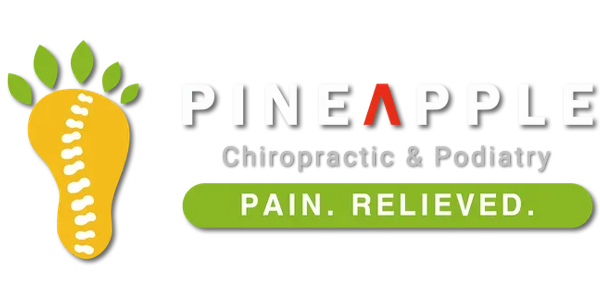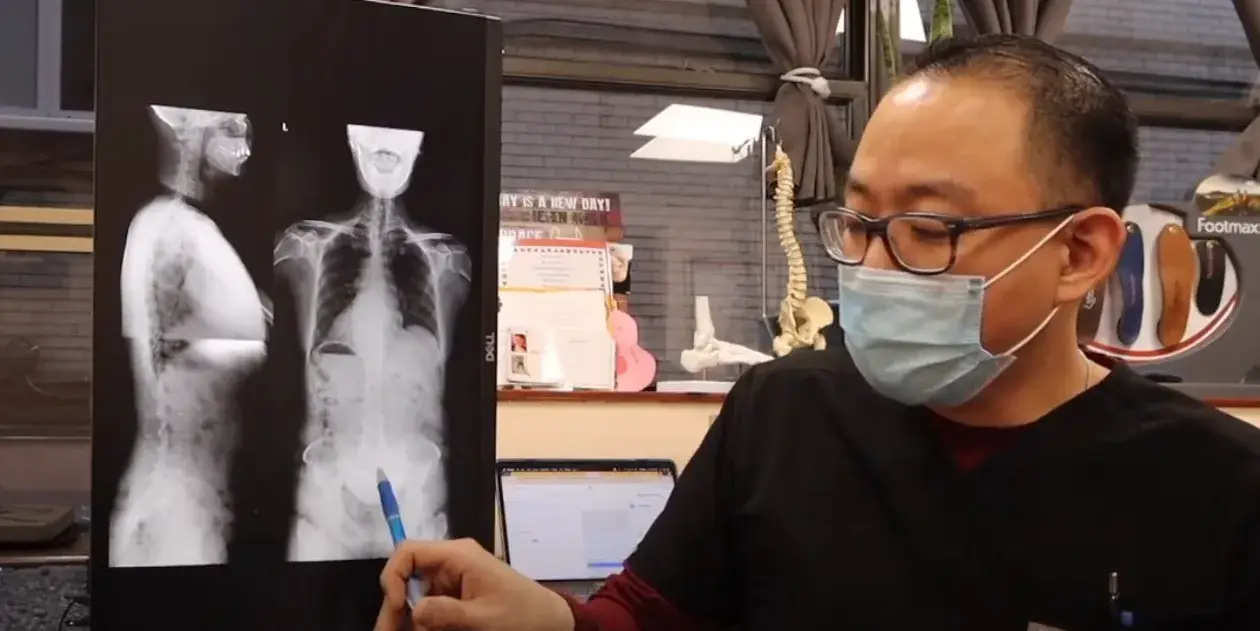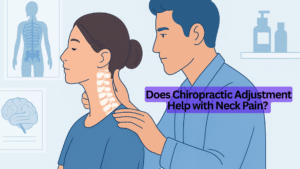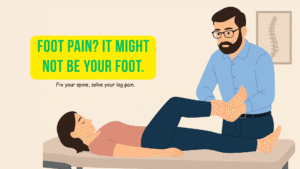Hip pain can be debilitating and affect daily life. Many seek relief through various methods, but have you considered chiropractic care?
As a chiropractor, I offer a non-invasive solution for hip pain. In my chiropractic sessions, after understanding the causes of your hip discomfort which could stem from various issues like joint problems, injuries, or even posture I will focus on aligning the spine and hips to relieve pain.
This approach helps restore mobility and reduces inflammation. By targeting the root cause, I provide lasting relief. In this blog, I will explore what causes hip pain, why chiropractic care is effective, and when you should visit me. I’ll also share some home tips for managing hip pain. Discover how I, Dr. Hyunjae Lee (D.P.M, D.C), can help you live pain-free.
What Is Hip Pain?
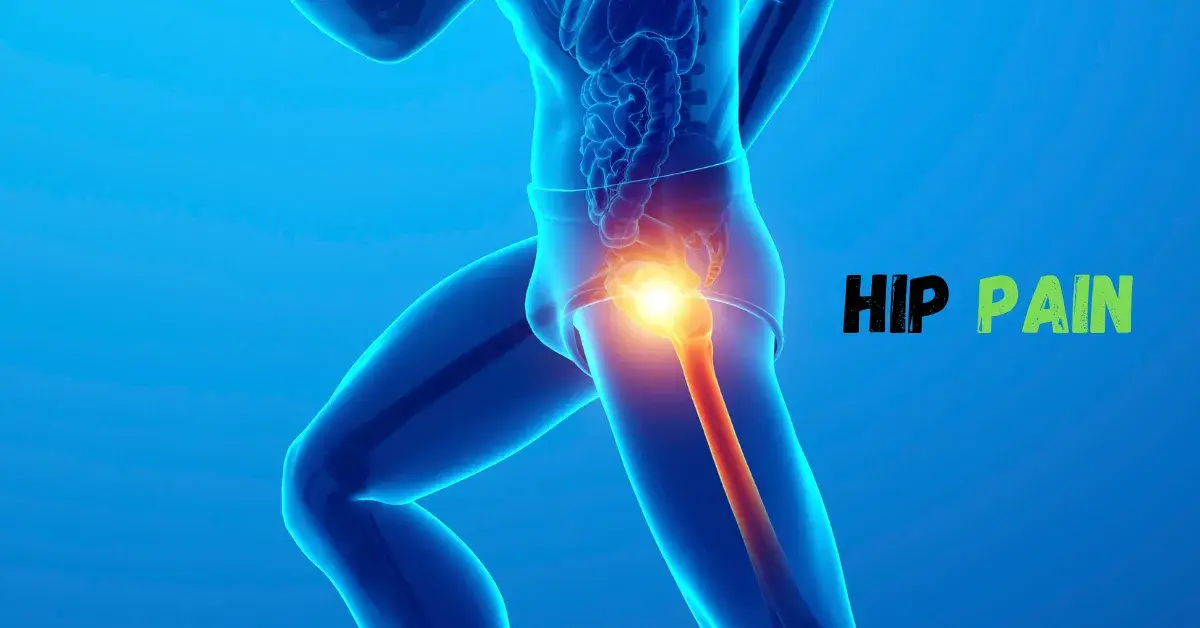
Hip pain can make daily activities difficult and uncomfortable. As a chiropractor, I use adjustments to ease discomfort and improve patient’s movement.
Hip pain can be a frustrating and limiting experience. Understanding the causes and symptoms is the first step towards finding relief. Let’s delve into what hip pain really is.
Causes Of Hip Pain
Various factors can lead to hip pain. Here are some common causes:
- Arthritis: Joint inflammation causing pain and stiffness.
- Bursitis: Inflammation of fluid-filled sacs cushioning the hip joint.
- Muscle Strains: Overstretching or tearing of muscles around the hip.
- Hip Fractures: Breaks in the upper part of the thigh bone.
Symptoms Of Hip Pain
Hip pain can manifest in different ways. Common symptoms include:
- Pain in the groin area.
- Discomfort in the buttocks.
- Pain radiating down the leg.
- Stiffness and reduced range of motion.
Types Of Hip Pain
Hip pain can vary in intensity and nature. Typically, it falls into these categories:
- Acute Pain: Sudden and severe, often due to injury.
- Chronic Pain: Long-lasting and persistent, usually from conditions like arthritis.
- Referred Pain: Pain originating from another part of the body.
Diagnosing Hip Pain
Proper diagnosis is crucial. Here’s how it’s generally done:
- Physical Examination: Assessing movement and pinpointing pain areas.
- Imaging Tests: X-rays or MRIs to view joint and bone conditions.
- Medical History: Discussing past injuries or conditions with a healthcare provider.
Understanding hip pain is key to seeking the right treatment. Identifying the cause and symptoms helps guide effective management.
What May Cause Hip Pain?
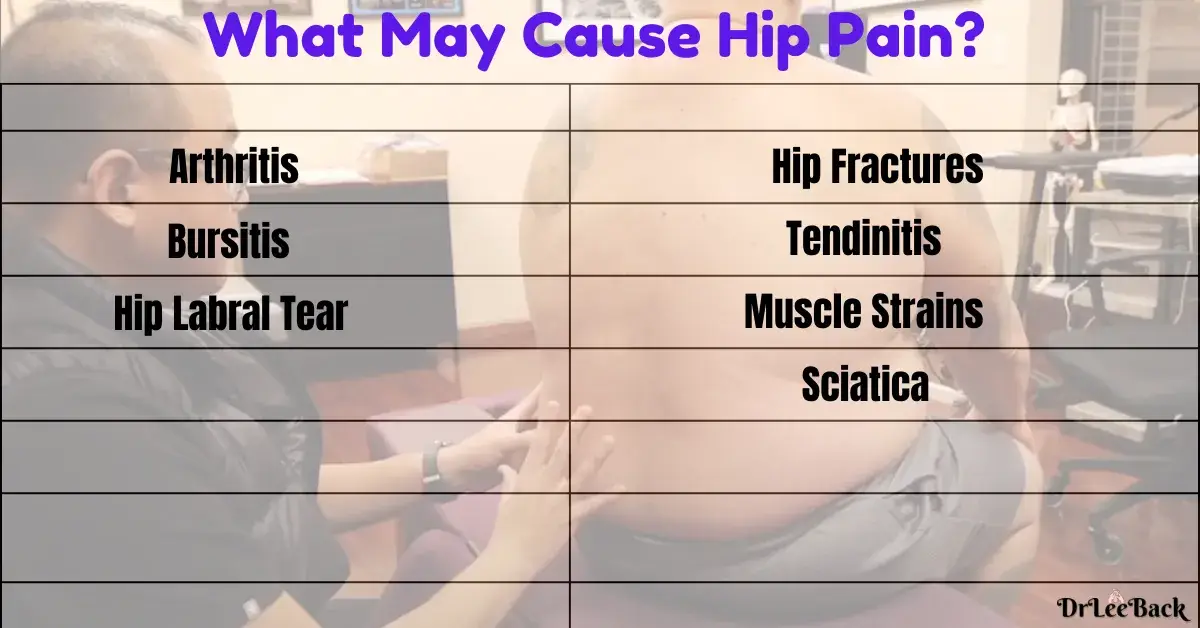
Hip pain can stem from various issues such as muscle strains, arthritis, or joint misalignment. I usually can help by adjusting the hip to improve alignment and reduce pain.
Experiencing hip pain can be frustrating and debilitating. Many factors contribute to this discomfort. Understanding these causes can help you find effective treatment.
Arthritis
Arthritis is a common cause of hip pain. It involves inflammation in the joints, leading to stiffness and pain. Types of arthritis affecting the hips include:
- Osteoarthritis: Wear and tear of joint cartilage.
- Rheumatoid arthritis: An autoimmune condition.
- Psoriatic arthritis: Associated with psoriasis.
Hip Fractures
Hip fractures are serious and often require immediate medical attention. They are common among older adults due to weakened bones. Factors contributing to hip fractures include:
- Osteoporosis: Bones become fragile.
- Falls: Accidents leading to breaks.
- Trauma: High-impact injuries.
Bursitis
Bursitis occurs when the bursa, a fluid-filled sac, becomes inflamed. This inflammation leads to pain and swelling. Causes of bursitis include:
- Repetitive activities: Overuse of the hip joint.
- Injury: Direct trauma to the hip.
- Infection: Bacterial infections affecting the bursa.
Tendinitis
Tendinitis involves inflammation of the tendons, which connect muscles to bones. This condition causes pain and tenderness around the hip. Contributing factors include:
- Overuse: Excessive strain on tendons.
- Aging: Natural wear and tear.
- Sports: High-impact activities.
Hip Labral Tear
A hip labral tear affects the cartilage surrounding the hip socket. This injury causes pain, stiffness, and limited movement. Common causes include:
- Trauma: Direct injury to the hip.
- Structural issues: Hip dysplasia or impingement.
- Repetitive motion: Sports or physical activities.
Muscle Strains
Muscle strains can result from overstretching or tearing muscles. This leads to pain and weakness in the hip area. Causes of muscle strains include:
- Overexertion: Excessive physical activity.
- Poor flexibility: Tight muscles.
- Improper warm-up: Lack of adequate preparation.
Sciatica
Sciatica is nerve pain originating in the lower back and radiating through the hip. It often results from nerve compression. Contributing factors include:
- Herniated discs: Displaced spinal discs.
- Spinal stenosis: Narrowing of the spinal canal.
- Piriformis syndrome: Compression of the sciatic nerve.
Understanding these common causes of hip pain can aid in identifying the right treatment. Consulting with me can provide relief and improve your quality of life.
Why Chiropractic Is Good For Hip Pain
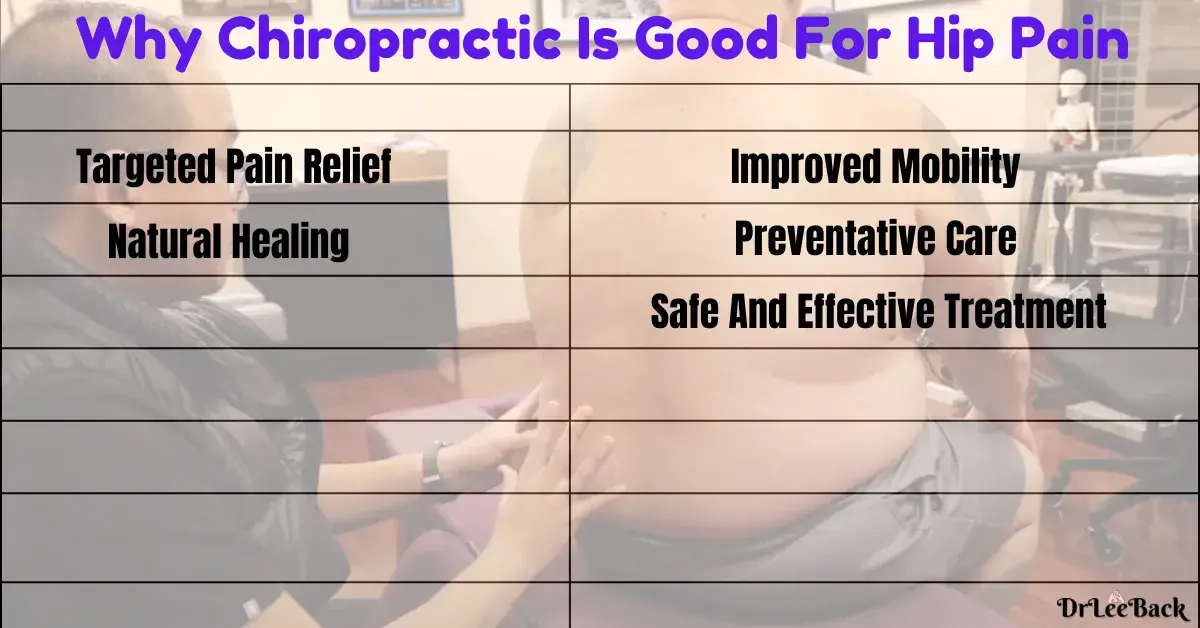
In chiropractic care, I offer a natural way to relieve hip pain by aligning the spine and joints. This approach can improve mobility and reduce discomfort.
Hip pain can disrupt daily life, making even simple movements difficult. Chiropractic care offers a natural way to alleviate this discomfort. Let’s explore why chiropractic is beneficial for hip pain.
Targeted Pain Relief
In my practice, I focus on the root cause of hip pain. I use specific techniques to target problem areas.
- Personalized treatment: Chiropractors create a custom plan for each patient.
- Holistic approach: They consider the whole body, not just the hip.
- Non-invasive methods: Chiropractors use hands-on adjustments and exercises.
Improved Mobility
Restoring movement in the hip joint is a key goal. Chiropractic adjustments can help achieve this.
- Increased range of motion: Adjustments help the hip move more freely.
- Reduced stiffness: Targeted techniques ease tightness in muscles and joints.
- Enhanced flexibility: Regular care can prevent future mobility issues.
Natural Healing
Chiropractic care supports the body’s natural healing processes. It focuses on helping the body repair itself.
Regular visits can:
- Stimulate blood flow: Improved circulation aids in healing.
- Reduce inflammation: Adjustments help decrease swelling and pain.
- Encourage tissue repair: Proper alignment supports muscle and joint recovery.
Preventative Care
It is true that I not only treat current pain but also work to prevent future issues. I provide guidance on maintaining hip health.
- Posture advice: Tips on sitting, standing, and moving correctly.
- Exercise routines: Specific exercises to strengthen hip muscles.
- Lifestyle changes: Recommendations on diet and daily habits for better joint health.
Safe And Effective Treatment
Chiropractic care is a safe option for many people. It avoids the risks associated with surgery and medication.
- No side effects: Unlike drugs, chiropractic care has no harmful side effects.
- Suitable for all ages: Safe for children, adults, and seniors.
- Complementary care: Can be combined with other treatments for better results.
By understanding these benefits, it’s clear why chiropractic care is a good choice for hip pain. Through targeted treatments and natural healing methods, I can help you move more freely and comfortably.
When Should You See Chiropractor For Hip Pain?
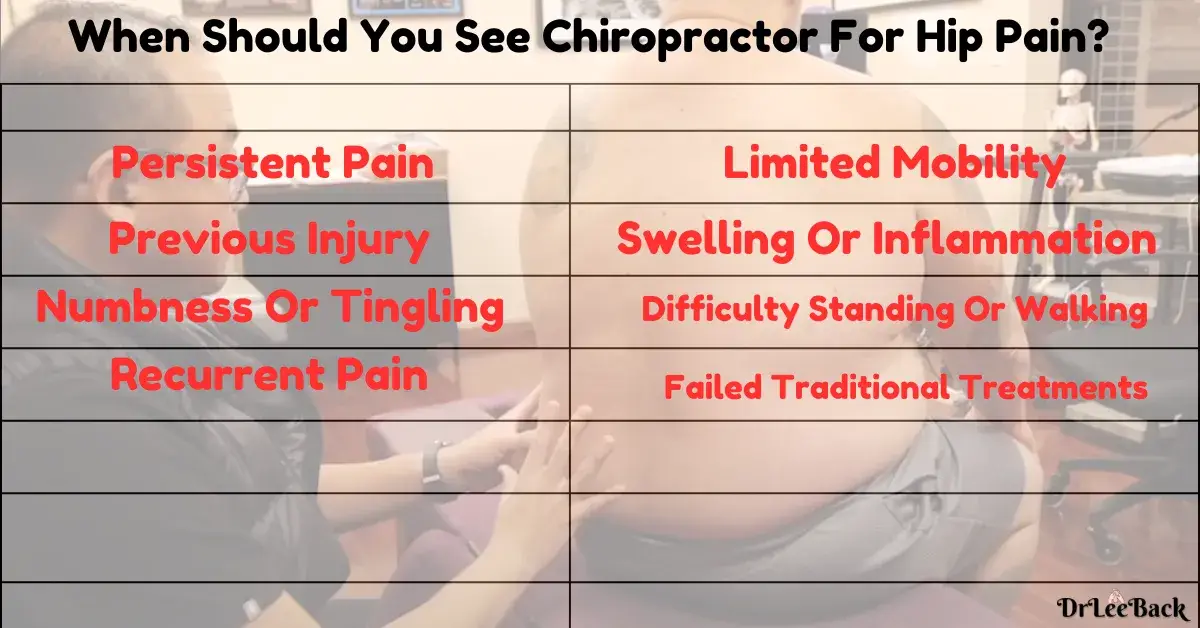
Experiencing persistent hip pain can interfere with daily activities. You can visit me if the pain lasts more than a week. I can help identify the cause and provide relief through adjustments and exercises.
Experiencing hip pain can be frustrating and debilitating. It can affect daily activities and overall quality of life. Knowing when to see me is crucial for effective treatment and relief.
Persistent Pain
Persistent pain is a sign to see me. Here’s why:
- Pain lasting over a week: Indicates a deeper issue needing professional attention.
- Pain worsening with time: May suggest a serious underlying condition.
- Interference with daily tasks: Impacting walking, sitting, or sleeping.
Limited Mobility
Sometimes, hip pain can restrict movement. This is another signal for chiropractic care. I can assess and improve mobility, helping you move freely again.
Swelling Or Inflammation
Swelling or inflammation around the hip is a concern. Consider these points:
- Visible swelling: Indicates inflammation that needs medical evaluation.
- Warmth around the hip: Suggests possible infection or joint issues.
- Pain when touching the area: May need chiropractic intervention for relief.
Previous Injury
A prior hip injury can lead to recurring pain. If you have a history of hip injuries, seeing me can prevent further damage and promote healing.
Numbness Or Tingling
Experiencing numbness or tingling in your hip or leg? This could mean nerve involvement. I can help alleviate pressure on nerves, reducing these sensations.
Pain Radiating To Other Areas
When hip pain spreads, it’s time to act. Consider these scenarios:
- Pain moving to the lower back: Could indicate spinal issues.
- Pain extending to the leg: Might signal sciatica or nerve problems.
- Discomfort reaching the groin: Needs professional evaluation to determine the cause.
Difficulty Standing Or Walking
Struggling to stand or walk is alarming. I can evaluate the hip and address the root cause, improving your balance and stability.
Failed Traditional Treatments
Sometimes, traditional treatments don’t work. If you’ve tried medications, rest, or physical therapy without success, I could offer alternative solutions.
Recurrent Pain
Recurrent pain can be exhausting. Here’s why to see me:
- Pain comes and goes: Needs a professional to find the underlying issue.
- Pain returns after activity: Indicates a persistent problem needing attention.
- Continuous discomfort despite rest: Suggests deeper issues that chiropractic care can address.
How Chiropractic Resolves Hip Pain
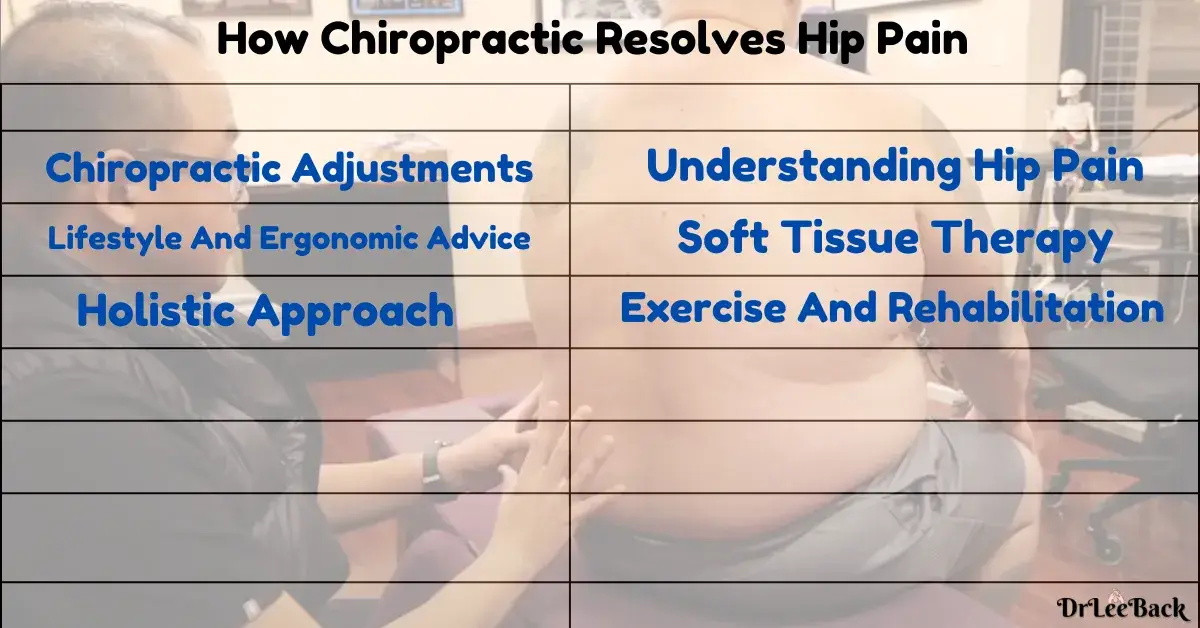
Generally I use gentle adjustments to align the spine and hips, reducing pain and improving mobility. These techniques relieve pressure on nerves, promoting natural healing.
Hip pain can be unbearable, affecting daily activities and overall well-being. Chiropractic care offers a natural solution to alleviate this discomfort. Let’s explore how chiropractic resolves hip pain.
Understanding Hip Pain
Hip pain often arises from various sources. I identify the root cause before treatment.
- Misalignment: Hip joint misalignment causes pain.
- Muscle tightness: Tight muscles around the hip strain joints.
- Nerve irritation: Irritated nerves lead to discomfort.
- Joint degeneration: Worn-out joints contribute to pain.
Chiropractic Adjustments
Chiropractic adjustments realign the spine and hips. This process eases pain and restores function.
- Gentle techniques: Chiropractors use mild force to adjust joints.
- Improved alignment: Proper alignment reduces pressure on the hip.
- Enhanced mobility: Adjustments increase range of motion.
- Pain relief: Aligned joints lessen pain significantly.
Soft Tissue Therapy
Soft tissue therapy complements chiropractic adjustments. It addresses muscle and ligament issues contributing to hip pain.
I employ various methods:
- Massage: Relieves muscle tension and pain.
- Stretching: Improves flexibility and movement.
- Trigger point therapy: Targets specific pain points.
- Myofascial release: Eases tight connective tissues.
Exercise And Rehabilitation
Exercise and rehabilitation play a crucial role in chiropractic care. I design personalized exercise programs to strengthen the hip area.
Key benefits include:
- Increased strength: Strong muscles support the hip joint.
- Better flexibility: Flexibility reduces the risk of injury.
- Enhanced balance: Improved balance prevents falls.
- Long-term relief: Regular exercise maintains hip health.
Lifestyle And Ergonomic Advice
I provide lifestyle and ergonomic advice to prevent hip pain. These tips help patients make healthier choices.
- Proper posture: Good posture reduces hip strain.
- Ergonomic setup: Proper workstation setup prevents pain.
- Healthy habits: Regular activity and proper nutrition boost overall health.
- Weight management: Maintaining a healthy weight eases hip pressure.
Holistic Approach
Chiropractic care takes a holistic approach to hip pain. It considers the whole body and not just the symptoms.
- Comprehensive assessment: Evaluates overall health.
- Personalized treatment: Tailored plans for individual needs.
- Preventive care: Focuses on preventing future issues.
- Patient education: Empowers patients to manage their health.
I offer a natural, effective solution for hip pain. This approach can improve quality of life and promote overall well-being.
Home Chiropractic Tips For Hip Pain
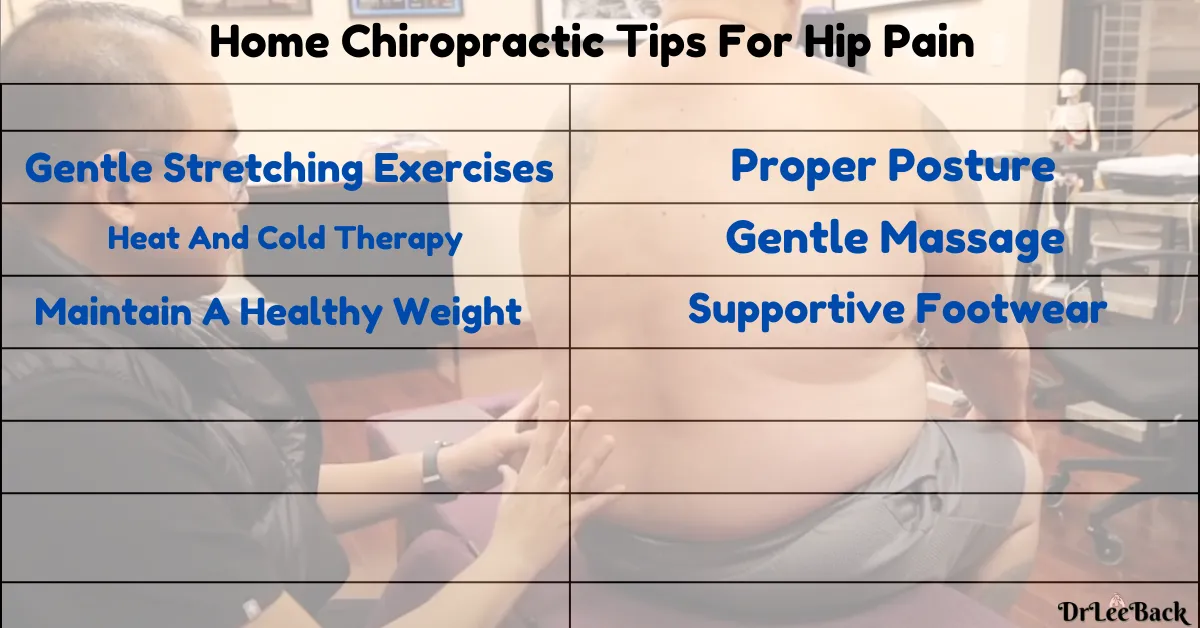
I can help relieve hip pain through adjustments and exercises. Regular chiropractic care can improve hip joint function. Simple home tips include stretching and maintaining good posture.
Experiencing hip pain can be frustrating. Fortunately, some tips can help manage this discomfort at home. These methods can complement your visits to me and may offer relief between appointments.
Gentle Stretching Exercises
Stretching helps improve flexibility and reduce hip pain. Simple exercises can be done at home with ease.
- Hip flexor stretch: Stand up. Step one foot back and bend the front knee. Hold for 30 seconds.
- Butterfly stretch: Sit with feet together. Gently push knees toward the floor. Hold for 30 seconds.
- Piriformis stretch: Lie on your back. Cross one leg over the other. Pull the uncrossed leg toward your chest.
Proper Posture
Maintaining good posture is crucial for preventing hip pain.
Sitting properly keeps the spine aligned. Stand tall and avoid slouching. Use chairs with proper back support. Keep your feet flat on the floor and your knees at hip level.
Heat And Cold Therapy
Applying heat or cold can provide relief from hip pain.
- Heat packs: Relax muscles and improve blood flow.
- Cold packs: Reduce inflammation and numb the pain.
Alternate between heat and cold for best results. Use each for 15-20 minutes at a time.
Gentle Massage
Massaging the hip area can alleviate pain and tension.
Use gentle, circular motions. Focus on the outer hip and buttock areas. A foam roller can also help. Roll gently to avoid causing more pain.
Maintain A Healthy Weight
Keeping a healthy weight reduces stress on your hips.
Excess weight can lead to increased pain. Eating a balanced diet and regular exercise can help. Aim for gradual weight loss if needed. This can greatly improve hip health.
Supportive Footwear
Wearing the right shoes is important for hip pain relief.
Choose shoes with good arch support. Avoid high heels and flats without support. Proper footwear can help align your hips and reduce pain.
Frequently Asked Questions
What Causes Hip Pain?
Hip pain can be caused by injuries, arthritis, or muscle strain. It may also be due to hip misalignment.
How Can A Chiropractor Help With Hip Pain?
A chiropractor can adjust the spine and hip to reduce pain. This helps improve mobility and function.
When Should You See A Chiropractor For Hip Pain?
See a chiropractor if hip pain lasts more than a week. Also, if pain interferes with daily activities.
Are There Home Tips For Managing Hip Pain?
Yes, apply ice to reduce swelling. Gentle stretches and over-the-counter pain relief can also help. Rest is important too.
THE END
Dealing with hip pain can be tough. In my clinic, I offer effective, natural relief. I address the root causes of your pain. Regular visits to me can improve your mobility. Don’t wait too long if pain persists. Seeking help early can prevent further issues.
Simple home tips can also support your recovery. Always listen to your body and take action. Visit me to get back to your best.
